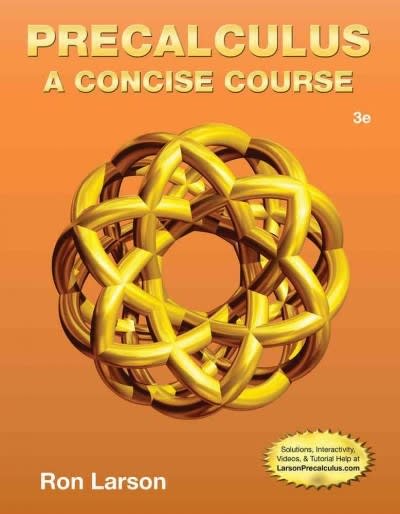Question
In this question, please use the data download from the FRED's website 1947:M1 to 2017:M12 Go to FRED's website (https://fred.stlouisfed.org/) and download the data for:
In this question, please use the data download from the FRED's website 1947:M1 to 2017:M12
Go to FRED's website (https://fred.stlouisfed.org/) and download the data for:
Consumer Price Index for All Urban Consumers: All Items (CPIAUCSL) - Seasonally adjusted - Monthly Frequency - From 1947:M1 to 2017:M12
In this hands-on exercise you will construct forecasting models for the rate of inflation, based on CPIAUCSL.
For this analysis, use the sample period 1970:M01-2012:M12 (where data before 1970 should be used, as necessary, as initial values for lags in regressions).
a.
(i)Compute the (annualized) inflation rate,
(ii)Plot the value of Infl from 1970:M01 through 2012:M12. Based on the plot, do you think that Infl has a stochastic trend? Explain.
b.
(i)Compute the first twelve autocorrelations of
(ii)Plot the value of from 1970:M01 through 2012:M12. The plot should look "choppy" or "jagged."Explain why this behavior is consistent with the first autocorrelation that you computed in part (i) for .
c.
(i)Compute Run an OLS regression of on . Does knowing the inflation this month help predict the inflation next month? Explain.
(ii)Estimate an AR(2) model for Infl. Is the AR(2) model better than an AR(1) model? Explain.
(iii)Estimate an AR(p) model for . What lag length is chosen by BIC? What lag length is chosen by AIC?
(iv)Use the AR(2) model to predict "the level of the inflation rate" in 2013:M01that is, .
d.
(i)Use the ADF test for the regression in Equation (14.31) with two lags of to test for a stochastic trend in .
(ii)Is the ADF test based on Equation (14.31) preferred to the test based on Equation (14.32) for testing for stochastic trend in ? Explain.
(iii)In (i) you used two lags of . Should you use more lags? Fewer lags? Explain.
(iv)Based on the test you carried out in (i), does the AR model for contain a unit root? Explain carefully. (Hint: Does the failure to reject a null hypothesis mean that the null hypothesis is true?)
e.Use the QLR test with 15% trimming to test the stability of the coefficients in the AR(2) model for "the inflation" . Is the AR(2) model stable? Explain.
f.
(i)Using the AR(2) model for with a sample period that begins in 1970:M01, compute pseudo out-of-sample forecasts for the inflation beginning in 2005:M12 and going through 2012:M12.
(ii)Are the pseudo out-of-sample forecasts biased?That is, do the forecast errors have a nonzero mean?
(iii)How large is the RMSFE of the pseudo out-of-sample forecasts? Is this consistent with the AR(2) model for estimated over the 1970:M01-2005:M12 sample period?
(iv)There is a large outlier in 2008:Q4. Why did inflation fall so much in 2008:Q4? (Hint: Collect some data on oil prices. What happened to oil prices during 2008?)
Step by Step Solution
There are 3 Steps involved in it
Step: 1

Get Instant Access to Expert-Tailored Solutions
See step-by-step solutions with expert insights and AI powered tools for academic success
Step: 2

Step: 3

Ace Your Homework with AI
Get the answers you need in no time with our AI-driven, step-by-step assistance
Get Started


